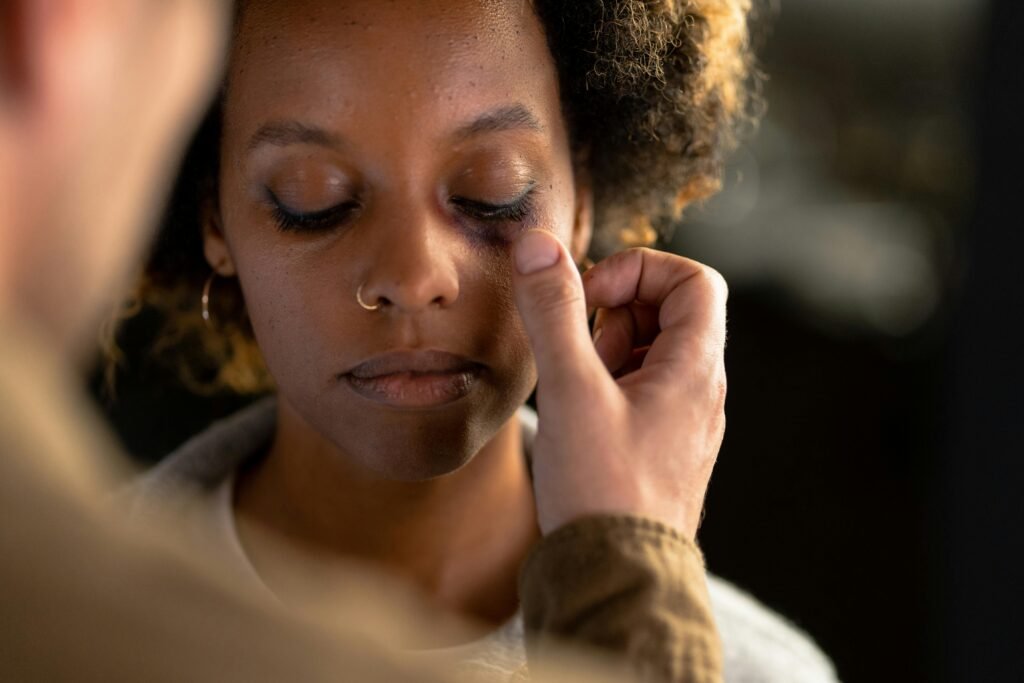Eye bags can make you look tired, older, and sometimes even grumpy—when all you really want is to look fresh and awake! Whether they’re caused by genetics, lack of sleep, or aging, they can be stubborn. Luckily, eye creams are here to help. These little jars of magic are specially formulated to target puffiness, dark circles, and fine lines, giving your under-eyes the love they need.
But do eye creams really work? And if they do, how? Let’s dive into the world of eye creams and see how they can help you fight those pesky eye bags.
Why Do Eye Bags Appear?


Before we talk solutions, let’s talk causes. Eye bags don’t just show up for no reason. Here are some of the main culprits:
- Aging: As we get older, the skin under our eyes loses collagen and elasticity, causing sagging and puffiness.
- Lack of Sleep: Poor sleep habits can lead to fluid retention and increased puffiness under the eyes.
- Genetics: If your parents have eye bags, chances are you might get them too.
- Allergies: Seasonal allergies or skin irritations can cause swelling and puffiness around the eyes.
- Dietary Habits: Too much salt in your diet can lead to water retention, making eye bags more prominent.
- Dehydration: Lack of hydration can make your under-eye area look sunken and dull.
The good news? Eye creams can help reduce puffiness and make your eyes look bright and refreshed.
How Do Eye Creams Work?
You might be wondering, how does applying a tiny bit of cream under my eyes make a difference? The answer lies in their targeted ingredients. Eye creams are packed with powerful skincare elements designed to hydrate, tighten, and brighten your under-eye area. Let’s break down how they work:
- Hydration: The skin around your eyes is thinner and more delicate than the rest of your face, making it prone to dryness. Eye creams provide much-needed moisture to keep it soft and plump.
- Depuffing: Ingredients like caffeine and green tea extract help to reduce swelling by boosting circulation and draining excess fluid.
- Brightening: Dark circles? No problem! Vitamin C and niacinamide work to brighten and even out skin tone.
- Firming: Peptides and retinol promote collagen production, making the skin firmer and less prone to sagging.
- Soothing: Chamomile, aloe vera, and hyaluronic acid calm irritation and provide a refreshing cooling effect.
By choosing the right eye cream, you can target your specific under-eye concerns and give your skin the care it deserves.
Key Ingredients to Look for in Eye Creams
Not all eye creams are created equal! Some formulas work better than others, depending on what’s inside. Here are some powerhouse ingredients to keep an eye out for:
- Caffeine: Reduces puffiness by tightening blood vessels and improving circulation.
- Hyaluronic Acid: A hydration superhero that plumps and smooths the skin.
- Vitamin C: Brightens dark circles and fights free radical damage.
- Peptides: Stimulate collagen production, keeping your skin firm and youthful.
- Retinol: Helps with fine lines and improves skin texture.
- Niacinamide: Evens out skin tone and strengthens the skin barrier.
- Green Tea Extract: Soothes and reduces inflammation.
If you’re dealing with stubborn eye bags, choosing an eye cream with these ingredients can make all the difference.
How to Apply Eye Cream for Best Results
Applying eye creams might seem simple, but a few extra steps can ensure maximum benefits:
- Use a Pea-Sized Amount: A little goes a long way! Using too much product can lead to irritation.
- Gently Dab, Don’t Rub: Use your ring finger to gently tap the cream into your skin—no harsh rubbing.
- Apply Before Moisturizer: Eye cream should be applied before your face moisturizer to ensure better absorption.
- Give It Time to Absorb: Let it sit for a few minutes before applying makeup or other products.
- Use It Morning and Night: Consistency is key! Applying eye cream twice a day helps maintain results.
Do Eye Creams Actually Work?
The million-dollar question: Do eye creams really work, or are they just a marketing gimmick? The answer depends on expectations and the product you choose.
Eye creams won’t perform miracles overnight, but with consistent use, they can significantly improve the appearance of eye bags. The right formula can hydrate, depuff, and brighten your under-eye area, making you look more awake and refreshed.
However, results take time. Most people see noticeable improvements after a few weeks of daily use. Pair your eye cream with good sleep, hydration, and a healthy diet for the best outcome.\
Common Mistakes When Using Eye Creams
Even the best eye creams won’t work if you’re making these common mistakes:
- Applying Too Much: More product doesn’t mean better results. Stick to a tiny amount.
- Rubbing Instead of Patting: Tugging at your under-eye skin can lead to more wrinkles.
- Using the Wrong Formula: Not all eye creams are the same—choose one that suits your specific concerns.
- Skipping Sunscreen: UV damage can make eye bags worse. Always wear SPF during the day.
- Expecting Instant Results: Patience is key! Give your eye cream time to work.
Lifestyle Changes to Boost Eye Cream Effectiveness


Want to maximize the benefits of your eye cream? Pair it with these simple lifestyle changes:
- Get Enough Sleep: Aim for 7-9 hours of quality sleep each night.
- Stay Hydrated: Drink plenty of water to prevent dehydration-related puffiness.
- Eat a Balanced Diet: Reduce salt intake and eat foods rich in antioxidants.
- Manage Allergies: Treat seasonal allergies to prevent under-eye swelling.
- Use Cold Compresses: Chilled spoons or cucumber slices can instantly reduce puffiness.
A good eye cream is a game-changer, but healthy habits will take your results to the next level.
Best Types of Eye Creams for Different Concerns
Not all eye creams are designed for the same problems. Here’s a quick guide to picking the right one:
- For Puffiness: Look for caffeine and green tea extract.
- For Dark Circles: Vitamin C and niacinamide are your best friends.
- For Wrinkles: Retinol and peptides help smooth fine lines.
- For Dryness: Hyaluronic acid and ceramides will keep your skin hydrated.
Choosing the right eye cream based on your concerns will give you better, faster results.
Say Goodbye to Eye Bags!
If eye bags have been making you look more tired than you feel, it’s time to add an eye cream to your routine. With the right ingredients and proper application, these creams can hydrate, depuff, and brighten your under-eye area.
Remember, consistency is key! While eye creams won’t erase eye bags overnight, they can make a noticeable difference over time. Pair them with good sleep, hydration, and a healthy diet, and you’ll be looking refreshed and well-rested in no time.
Frequently Asked Questions: How Eye Creams Can Help You Deal with Eye Bags
1. Do eye creams really work for eye bags, or is it just marketing hype?
Yes, they can work—but only if you’re using the right one for your specific problem. Not all eye bags are the same. Some are caused by fluid retention (hello, salty midnight snacks), others by fat pads shifting as you age, and sometimes it’s just genetics doing its thing. The trick is to find an eye cream that actually targets your issue. Caffeine-infused eye creams help with puffiness by tightening the skin and reducing fluid buildup, while creams with peptides and retinol work better for long-term firmness. The key is consistency. Don’t expect a miracle overnight, but give it a few weeks, and you might be surprised.
2. What ingredients should I look for in an eye cream to actually reduce puffiness?
If your goal is to wake up looking fresh and well-rested (even if you only got four hours of sleep), you need to check the ingredient list. Caffeine is a rockstar because it constricts blood vessels, reducing swelling fast. Hyaluronic acid is great for hydration, making your skin look plumper and smoother. Retinol boosts collagen to tighten saggy skin over time, and peptides help with strengthening and firming. Also, anything with antioxidants like vitamin C or green tea will help protect your under-eyes from environmental stress (like pollution and screen time). But here’s the real secret: storing your eye cream in the fridge makes it even more effective. That cooling effect? Instant de-puffing magic.
3. Can eye creams replace sleep, or do I still need to fix my sleep schedule?
As much as we all wish eye cream could be a magical “erase last night’s bad decisions” button, the reality is that nothing beats actual rest. Eye creams help with damage control—like reducing swelling, hydrating dry skin, and improving elasticity—but they can’t completely reverse the effects of chronic sleep deprivation. If you’re constantly running on empty, your under-eyes will show it. That said, using an eye cream with brightening ingredients (like niacinamide or vitamin C) can at least make you look like you got a full eight hours, even if you totally didn’t. So yeah, keep your eye cream in rotation, but also fix that sleep schedule, bestie.
4. How do I apply eye cream the right way? Am I doing it wrong?
A lot of people make the mistake of rubbing it in like regular moisturizer, and that’s a no-go. The skin around your eyes is super delicate—basically paper-thin—so tugging and pulling just speeds up wrinkles. Instead, take a tiny amount (seriously, a pea-sized drop is enough for both eyes), tap it gently using your ring finger (it’s the weakest one, so less pressure), and work from the inner to the outer corners. If your eye cream has active ingredients like retinol, avoid applying too close to your lash line to prevent irritation. Also, don’t forget your upper eyelids if the cream is safe for that area—droopy lids can be just as annoying as under-eye bags.
5. Will using an expensive eye cream give me better results?
Not necessarily. Some drugstore eye creams have the same key ingredients as high-end ones, just with less fancy packaging. The real difference is in the formula and concentration of active ingredients. If a luxury eye cream has a more potent mix of peptides, antioxidants, and hydrators, it might work better—but that doesn’t mean budget-friendly options can’t get the job done. The best thing to do is check the ingredients, read reviews, and find one that actually targets your under-eye issue. Sometimes, you’re just paying for the brand name and the sleek little jar.
6. How long does it take for an eye cream to work?
This depends on what you’re trying to fix. If you’re dealing with temporary puffiness (maybe from a late night or too much sodium), you might see results within minutes—especially if the cream has caffeine or cooling ingredients. For dark circles and long-term firmness, though, you need patience. It can take around 4 to 6 weeks of consistent use to see real improvements. Retinol and peptides take time to boost collagen, and brightening ingredients like vitamin C gradually fade discoloration. So if you’re on week two and wondering why your eye bags haven’t vanished yet, give it time. Consistency is key.
7. Can I just use my regular face moisturizer instead of an eye cream?
Technically, yes. But here’s the catch—most face moisturizers aren’t formulated for the sensitive eye area, so they might be too thick, too greasy, or even irritating. Eye creams usually have a lighter, gentler formula designed to absorb quickly without clogging pores or making your under-eyes look shiny. If you’re in a pinch, using a basic fragrance-free moisturizer with hydrating ingredients like hyaluronic acid is fine, but if you want to target puffiness, dark circles, or fine lines, an actual eye cream will do a better job. It’s like using body lotion on your face—it might work, but it’s not really the best idea.
